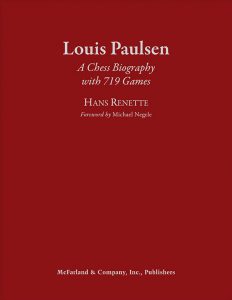
A copy of “Louis Paulsen : A Chess Biography with 719 Games” was received today at our editorial office. We look forward to reviewing this book by Hans Renette with great anticipation !

BCN is delighted to have received recent publications from McFarland Books. They are :
British Chess Literature to 1914 : A Handbook for Historians by Tim Harding
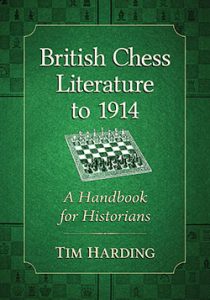
and
Tal, Petrosian, Spassky and Korchnoi : A Chess Multibiography with 207 Games by Andrew Soltis

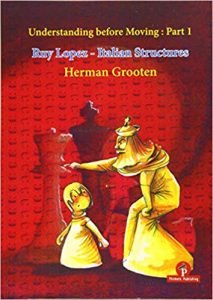
The author of this book Herman Grooten is an International master and has taught players such as Loek van Wely.

At the start of the book Grooten emphasises that many chess players memorise lots of opening theory but it does not improve their results as they do not understand the position when their opponent deviates from theory.
He explores the various pawn structures in variations of openings in the Ruy Lopez (Spanish Game) and (Giuoco Piano) Italian game.
The first variation he looks at is the so-called Berlin wall (Berlin Defence) which was used very successfully by Vladimir Kramnik in his World Championship match vs Gary Kasparov.
Knowing Kasparov was a great attacking player Kramnik chose a variation which leads to a Queenless middle game.
Although Black ends up with doubled pawns on the Queenside (as in the Ruy Lopez, Exchange Variation) his bishop pair is good compensation and his doubled pawns are not weak and easily exploited.
Grooten then shows what each side should be trying to achieve to progress their position.
In the Open Lopez the pawn structure is very different : White has a four to three pawn majority on the kingside and with a pawn on e5 and good use of the d4 he has good chances for an advantage and it is well known that Viktor Korchnoi played the Open Lopez in his famous match with Anatoly Karpov. Black has a four to three majority on the queenside but his c7 pawn is backwards and weak. If Black can play c5 then he will probably equalise but he normally cannot afford to play Nxd4 as after cxd4 his c7 pawn is very weak.
Next Grooten examines variations of the Closed Lopez where play typically goes 5 Be7 6 Re1 b5 7 Bb3 00 8 c3 d6 9 h3. Here the Zaitzev 9…Bb7 Chigorin 9…Na5 and Breyer 9…Nb8 are explored in detail. In all three of these famous lines the pawn structure is the same White pawns on c3 d4 and e4 Black pawns on c5 d6 and e5.
White normally can decide the structure by either playing d5 or d4xc5 or maintain tension with Nbd2 when Black can change the structure with c5xd4,
Paul Keres often did this in the Chigorin Variation.
Grooten looks in depth at the theory of the Two Knights where White plays 4 Ng5 including some variations in the main line 5 Na5 which I have not seen before and maybe are unusual and interesting.
Finally, He also looks at some interesting world class games the best of which is a win by Paul Keres over Mikhail Tal as Black in the Chigorin Variation.
In summary, this excellent book will appeal to club players who know these openings but are not sure what plan(s) to adopt in the consequent middle game.
Colin Lyne, Farnborough, Hampshire, May 1st, 2019
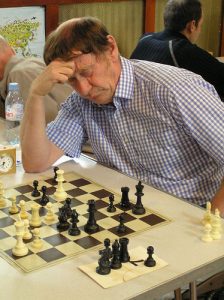
Book Details :
Official web site of Thinkers Publishing
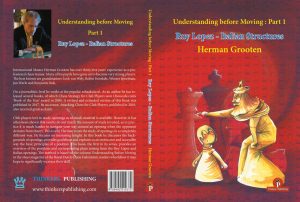

Gata Kamsky was born in 1974 in Siberia. When moved to Leningrad he became a student of the renowned veteran trainer, who had coached since about 1945, witness Spassky and Korchnoi ! and author (‘Improve Your Chess Results’ and ‘The King’s Gambit’ with Viktor K), Vladimir Zak. At 12 he won the USSR Junior Championship. However, early journeys into the top game were not always successful and his fast track was criticised even by Botvinnik himself.

His father brought Gata up alone and loomed large in the prodigy’s life, Kamsky Senior even stopping Short in his tracks (“Where is your father?”). He was moved to the USA in 1989 but, sadly, has recently stated that he was never fully accepted. He became GM shortly afterwards.

Although a 1996 FIDE World Championship challenger, he lost a well contested match versus Karpov, whereupon Kamsky Senior announced Gata intention to pursue a career in medicine. He had withdrawn from the game, was seeking a teenage bride, and by order!
This book deals with the first part of an incredible career up to 1996. It centres on 22 games, all against fellow grandmasters, all with very deep notes. The text lacks an index. No attempt is made to list his tournament record, or give family photos or reminiscence. It is the first of two volumes, the second yet to appear.
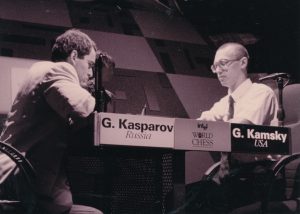
A recent interview on ‘Perpetual Chess Podcast’ saw Gata labeling himself an advocate of the Lasker School. He emerges from an era when preparation might even be considered cheating. a big fan of endgame studies. Further, he is revealed as almost humble, of great depth who, the introduction to his book states, as author, seems to want to be compared with Fischer. I don’t agree but, BCN, as ever, welcomes correspondence here.

Potential buyers of this book, which is subtitled ‘Awakening’ should definitely listen in to his interview and please let us know what you think.

James Pratt, Basingstoke, April 2019
Book Details:
Official web site of http://www.thinkerspublishing.com

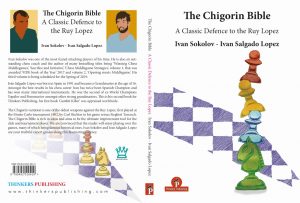
The Chigorin defence to the Ruy Lopez comes about when black plays the closed 5…Be7 variation and play continues 6.Re1 b5 7.Bb3 d6 8.c3 00 9.h3 now black unleashes 9…Na5.
The opening is named after the Russian player Mikhail Ivanovich Chigorin (1850 to 1908) who twice played Wilhelm Steinitz for the world title, losing on both occasions.
The authors of the book are Dutch Grandmaster Ivan Sokolov and Spanish (appropriately enough !) Grandmaster Ivan Salgado Lopez.

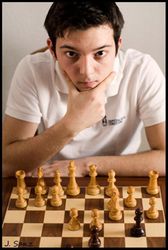
Anyone playing the black side of 1.e4 e5 2.Nf3 Nc6 has to face the problem of how to get equality after 3.Bb5 undoubtedly the most challenging move. White’s normal strategy will often be to play for a kingside attack and therefore black needs to find a good defence that gives him equal chances and the opportunity to take over the initiative if white goes astray. The two Ivans offer a defence to the Ruy Lopez that seems to do that and one which is a lot more interesting than the (in my opinion) boring (according to many!) Berlin Defence.
Firstly, I was surprised to learn that this opening variation was first played by (1910 World Championship Challenger) Carl Schlechter in 1902 and his opponent was Dr. Siegbert Tarrasch. Chigorin himself played the defence twice but it was Akiba Rubinstein who made the opening popular playing it many times against world class opponents. Later on Capablanca, Lasker, Botvinnik, Euwe, Reshevsky and particularly Paul Keres all helped to make it a popular response to the Spanish Opening.
The book starts out by discussing early games and detailing middle game plans for Black. The first variation to be discussed in detail is 10.Bc2 c5 11.d4 Qc7 12.Nbd2 citing the stem game Lasker vs Tarrasch giving an excellent example of how black should play the position. A whole chapter then looks at the games of Paul Keres (most of which he won) however it does not include his famous game v Robert James Fischer (Zurich 1959) which is nevertheless analysed in another chapter : Fischer won that historic encounter.
An attractive (and unusual ) feature of this book is that it also points out best lines for White to play rather than simply evangelizing the Chigorin Variation from Black’s perspective. An example of this is when black chooses 11…Bb7 over 11…Qc7 and after 12.d5! it is difficult for black to activate the bishop or the knight on a5.
A better 11th move for Black is Nd7 which features in several games. Here again the author’s point out that 12.d5 is playing into blacks’ hand as he plays Nb6 intending f5. A better try is 12.a4 as a number of high level games demonstrate.
The latter part of the book discusses much theory and sums up which lines are promising for each player and which are to be avoided.
Summing up, I would say that this is an excellent book and any player studying it is likely to be better prepared than their opponent for sure.
Colin Lyne, Farnborough, Hampshire, April 16th, 2019

Book Details :
Official web site of Thinkers Publishing


After four years, ending in 2014, of working with the Bulgarian Grandmaster, Veselin Topalov, the second (“a Second generally has to work at night, often all night”) to the former FIDE World Champion speaks of his duties, preparation and with colour (“He fought like a lion for 71 moves”). It is a tale of dedication and loyalty to a seemingly fearsome character. (Presumably this could not have been written whilst the author, who is also the Managing Editor of Thinkers series, was under contract?!)
Chapters: A World Apart. The Start of Our Co-operation. Learning the Job. Zug More Success! Tough Times in Thessalonika. Rollercoaster in Beijing! Preparing for the Candidates. The Candidates Tournament. A Few Novelties More. Exercises 24 positions and Solutions.
Many annotated games, mostly recent, no Rabars but ratings quoted. Use of smaller diagrams in notes (good!). A few cartoons and 7 crosstables. Very artistic colour cover. No index.
Digestible and thorough and, happily, honest. The author has been a French grandmaster for the last decade.

James Pratt, Basingstoke, April 2019
Book Details:
Official web site of http://www.thinkerspublishing.com


This is a relaxed and almost carefree publication written by a grandmaster little known to me, though I imagine readers of BCN will not confuse him with Gennady Kuzmin (b.1946). Alexey was, in fact, born in 1963 and is sensibly introduced on the back of this weighty paperback, a recent arrival from Thinkers Publishing who are, in turn, a new publisher in the realm of the Royal Game.

The subject matter is the Candidates tournaments and matches – almost all staged within FIDE – and bears the sub-title ‘Budapest 1950 to Berlin 2018’.
Certainly the book, which features test positions, crosstables, black and white photos, no index, a very artistic aqua marine cover, six chapters, a key to symbols and, of course, well annotated games, should be of interest to many players. Not all the games are from candidates matches or tournaments but this surely doesn’t matter. And I did say it has relaxed in approach.
Younger readers will, I hope, enjoy a bit of history as the qualification history is relived and the old names, so many champions from the time of Botvinnik onwards, are resurrected respectfully and with relish.
I spotted a few mistakes. The numbering of the Tests, which surely might have been sequential, is the same in each chapter. Jussupow called himself Yusupov as long ago as 1986 and some of the photos are so dark that they are hardly worthwhile.
I would like to like this book but it is a bit of a mix, a hotch-potch, at least in my opinion. Certainly it is pleasantly free from misprints and original in concept.

James Pratt, Basingstoke, April 2019
Book Details :
Official web site of http://www.thinkerspublishing.com

Chess Opening Traps for Kids : Graham Burgess
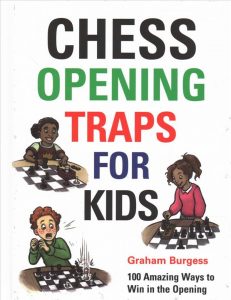
FIDE Master Graham Burgess needs no introduction to readers of English language chess books ! Minnesota, USA based, Graham has authored more than twenty five books and edited at least 250 and is editorial director of Gambit Publications Ltd. In 1994 Graham set a world record for marathon blitz playing and has been champion of the Danish region of Funen !

Readers may remember “101 Chess Opening Surprises” published in 1998, also by Gambit Publications, was well received and added to GKBs reputation for originality, accuracy and encyclopedic knowledge of openings.
Chess Opening Traps for Kids is the fifth in a series of “for Kids” books and is robustly (!) hardbound in a convenient size such that weights are not need to keep it propped open (unlike some A5 paperbacks) meaning studying with this book is more convenient than with many books. The layout and printing is clear (as you would expect with Gambit) with numerous diagrams at key moments in each, relatively short, game. In essence, players under 18 (for whom this book is intended) will find it easy to dip in out of and it can be used without a board (although BCN would always recommend following each game on a “proper” board).
As you would expect with Gambit, the notation is English short form algebraic using figurines for pieces. One slight criticism is that the diagrams do not have “whose move it is” indicator. We know that many readers like to see this on all diagrams. However, each diagram does have coordinates; welcome for the junior readership.
Graham has identified and described 100 unique themes (usually tactical) that lead to relatively short wins out of the opening, many of which could be termed “miniatures”. An example theme is “Drag the King Out with Nxf7” : “Sometimes players leave f7 so weak that a knight sacrifice on that square wins by force. The signs to look out for are a queen that can invade on e6 and other pieces ready to support the raid.” Under this theme the author presents three examples (typical for each theme) from different openings plus supporting analysis and explanation.
A range of openings are demonstrated that yield a similar trap. For example, The Siberian Trap is shown from the usual perspective of the Sicilian Defence and the Queen’s Gambit Accepted. In the main, the author does not get bogged down giving details of who were the players of the games and when and where they were played but does in a few cases where the players are especially well known.
The author’s explanations and language are clear, concise and presented with a friendly and engaging style. There are numerous cross references to other themes when an idea uses a previously mentioned one. All of this contributes to the learning experience and the pattern recognition aspects of chess that are especially important for young players in their formative years. Thankfully, there is no recourse to engine evaluations and the emphasis is to use one’s personal brain engine in making an assessment. (One of our bugbears as chess teachers and coaches is juniors increasingly relying on engine assessments rather than their own brains).
Having worked through the 100 themes the student is presented with 48 exercises (with solutions) that test the students understanding (not memory) of what they hopefully have learnt.
Finally there are useful tips on further improvement and how to make progress.
In summary, this is an excellent book with much original material presented in a clear and friendly way and therefore to be recommended.
One negative comment we would make concerns the cover. “Never judge a book by its cover” we are told and you might look at this book cover and think it was suitable for say primary aged children. I would say not but I would suggest it suitable from secondary aged children. I would say strong juniors from 12 upwards would read this book and enjoy it.
Apart from the “move indicator” we would like to see an index of openings from which the theme examples were obtained.
The title and cover might, perhaps, put off the adult club player market. However, the content is totally suitable for adult club players upto say 180 ECF or 2000 Elo.
As a postscript, we have reviewed the follow-up workbook here
John Upham, Cove, Hampshire, April 5th 2019

Book Details :
Official web site of Gambit Publications Ltd.

The Modernized Caro-Kann : Daniel Fernandez
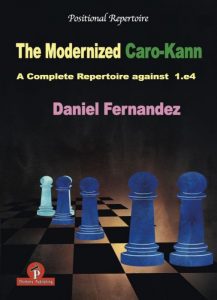
This book, written by the young English GM Daniel Fernandez and published by Thinkers Publishing, is (as the sub-title suggests) a repertoire book for Black players of the Caro-Kann defence. As such, Fernandez does not cover all possible black lines, but instead he recommends lines against each of the systems that White can employ against the Caro-Kann – and in many instances he recommends more than one line so that the reader can choose according to preference.
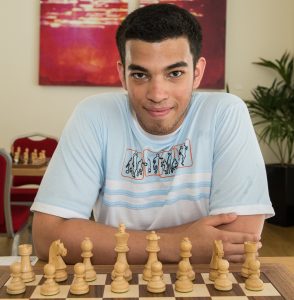
His repertoire consists of one or two solid (but not sterile) lines against each system, but additionally he throws in the occasional not-so-sound line (and always warns that he is doing this) that can be tried as a surprise weapon, or perhaps at faster time controls.
This is an excellent book, Fernandez manages to mix detailed analysis, explanations and personal opinion in a way which makes the book readable and enjoyable to go through (and believe me, some of the analysis is very detailed). The book is well produced and organised, and quite substantial at 416 pages. There is no detailed Index of Variations (usually a bugbear of mine!), but it is easy to find the line you’re looking for from the Table of Contents and the beginning of the book and a mini-Table of Contents page at the beginning of each chapter for the sub-variations.
I would highly recommend this book for anyone thinking about taking up the Caro-Kann, and for that matter to anyone who already plays it – it is one of the best opening books I have seen.
It is difficult to discuss this book without comparing it to Jovanka Houska’s book “The Caro-Kann” produced by Everyman Chess. Both books are recent (Houska 2015, Fernandez 2018) repertoire books by top English players who play the Caro themselves. (It is the Houska book that I used when I started using the Caro a couple of years ago.) In my opinion, both books are top-notch and provide the prospective Caro player with a good repertoire. If asked which book I would recommend this prospective Caro player to buy I would answer “both of them” – despite the overlap there are substantial differences in some lines (for example Houska recommends 4 …Bf5 after 1 e4 c6 2 d4 d5 3 Nc3 dxe4 4 Nxe4 whereas Fernandez recommends 4 …Nd7 here) and this gives players more choice over the lines they select. Of course, if budget does not permit buying both books then either one will do the job. I would be reluctant to choose only one of these excellent books, so I will not do so.
In summary: The Modernized Caro-Kann is an excellent choice for prospective Caro-Kann players, or indeed for those who already play the Caro-Kann and are looking to update their repertoire.
Colin Purdon, March 4th 2019

Book Details :
Official web site of Thinkers Publishing
 available
available
The content of the book is available as a training course as part of ChessAble

Christian Bauer (born 11 January 1977) is a French Grandmaster and author. He is a three-time French Champion and the author of three opening books. This collection of the authors best games is his first book for Thinkers Press.

What makes this book unique is that each game is annotated twice, firstly from the perspective of the white player followed by the same game with the annotations this time from the black player. The book contains 38 very deeply annotated games from the perspective of both players played between 2007 and 2017.
The book is divided up into four chapters : chapter 1 covers the topic of the exchange sacrifice, chapter 2 covers tactically complex positions, chapter 3 covers games where one king remains in the centre, and finally, chapter 4 covers “quieter games”.
This a very well produced book. Recently I have had the pleasure of reviewing two other books from Thinkers Publishing and, as with this book I have been impressed with the high quality of the publication. But, the book does not come with an index of games or a list of openings. My first criticism of this book is the title “Candidate moves” : when you start to read this book you would assume that the book is going to discuss the selection of candidate moves, but the book doesn’t do that, in fact I would go as far as saying that the title bears no relation to the contents whatsoever. Does this mean that this is not a good book? Far from it, there are many interesting and hard fought games here and the standard of annotation is consistently high throughout. I did however notice a number of inconsistencies with the annotations where for example a move is considered bad or dubious in one ‘version’ but is passed over without comment when annotated from the other players perspective.
The author does like to side step mainstream opening theory and play offbeat or even unsound openings, e.g. In Chapter 4, Game 17 against R Wojtaszek (2724) the game begins 1d4 a6 and in Game27 against D Semcesen (2469) starts 1. c4 e5 2.a3!? and the rationale was that as his opponent likes to play the line 2Nc3 Bb4 against the English opening he thought that he would see if opponent would be bothered by 2. a3. These are games from classical tournaments played by a top ranking chess professional, not games from a blitz or rapidplay event. Could you play like that?
The double annotation method was to try and diminish the subjectivity in the annotations and is a unique and innovative approach. I have seen the idea of multiple perspectives work in films but I don’t think that it really works here. I did enjoy playing through several of the games in the book and I may even try out some of the opening ideas myself but overall I don’t think that the idea works. You can achieve the same result by including all the annotations within one game.
Tony Williams, December 8th 2018

Book Details :
Official web site of Thinkers Publishing
